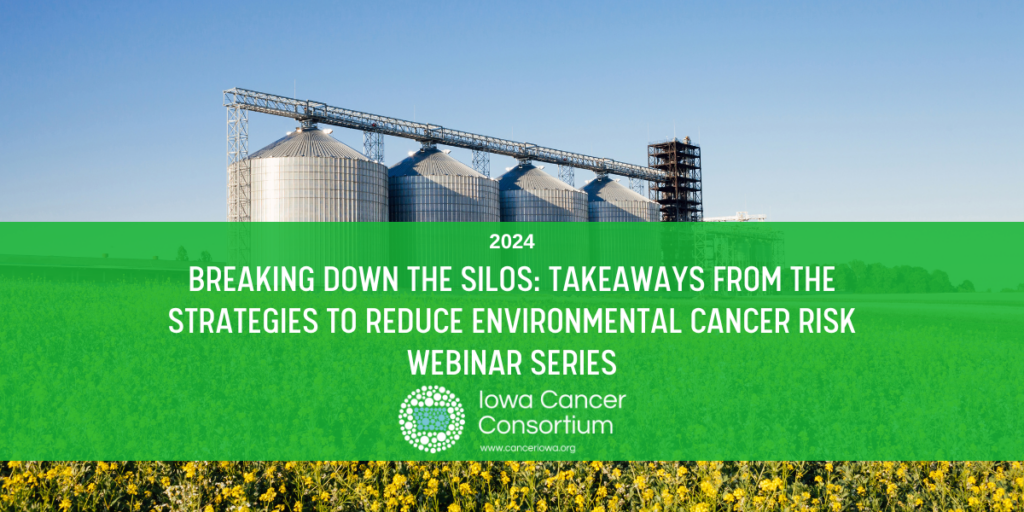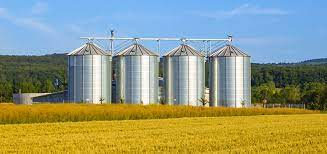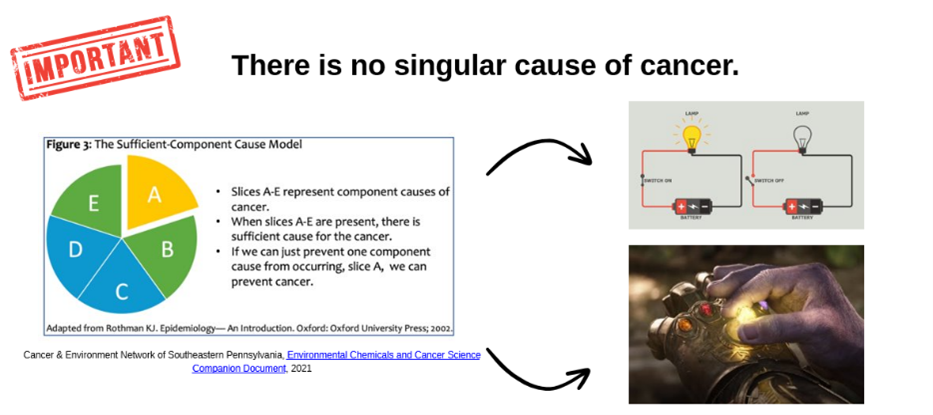Breaking Down the Silos: Takeaways from the Strategies to Reduce Environmental Cancer Risk Webinar Series

For most people, especially those familiar with farmland, what comes to mind when you think of a silo is a tall metal tower that stores grain. It is known for its large size and protective quality, but also for its potential danger of entrapment. The grain that provides sustenance can also overwhelm the people working in them. A similar predicament exists when we think of a mental silo, which is when an organization or team lacks information-sharing and collaborative opportunities, despite working on common issues. Whether this is by choice or circumstance, organizational siloing is a barrier to addressing overwhelming health issues like cancer that require working together across fields.

Since its inception in 2023, the Iowa Cancer Consortium’s Cancer and the Environment Task Force aims to connect partners with resources, knowledge, and collaborative opportunities. The intent is to help them succeed in practicing cancer control work through an environmental and occupational health lens, and vice versa. The goal of the Iowa Cancer Consortium’s latest webinar series, “Strategies to Reduce Environmental Cancer Risk,” was to move beyond promoting awareness of cancer-causing or cancer-promoting substances in our environments to providing tangible actions and advocacy opportunities that participants could tailor to the communities they live in and serve.
If you have been following the Consortium’s environmental health literacy work, you may already be familiar with the “cancer pie.” We have also used an electrical circuit, and even Thanos’ gauntlet, as relatable analogies to emphasize that cancer is a complex set of diseases that cannot be attributed to a singular cause. In combination with genetics, factors that influence cancer risk include exposures to naturally occurring or manmade hazardous substances, but also the built environments and sociocultural norms that influence health behaviors, like smoking or drinking alcohol and accessing healthy food and spaces for physical activity. The environments we spend time in can serve as sites of cancer prevention or cancer promotion depending on the exposures, resources, and policies that they are made up of, and not all environmental factors are within the individual’s control. As we continue to build and maintain partnerships that can help keep the environmental and occupational exposures pie slice or infinity stone gauntlet unfilled, we continue to learn with and from a variety of experts.
At the end of each session of our webinar series, we asked our speakers what role they see cancer control and public health professionals playing in their respective environmental and occupational health fields. Below is a summary of suggestions for cancer control and public health professionals (click on the topic to view the webinar recording):
Improving Water Quality: Having public health expertise or direct experience working with people who have health issues stemming from poor water quality is beneficial and needed. These experts bring a credible voice and perspective to the sometimes divisive issue of water quality that is valuable in any conversation about the quality of our water in Iowa.
Promoting Safer Agriculture: Farming techniques may seem unrelated to the cancer control work you do daily, but agriculture does have direct and indirect impacts on the communities you serve. Voices, expertise, and credentialing matter when advocating for rural communities and occupational settings that are not well protected, so keep being curious and having these conversations. Invite rural and agricultural communities to help inform your health messaging, including where you do outreach and what format will be best received.
Minimizing Plastics Use: Policymakers and companies have a role in reducing exposures to endocrine disrupting chemicals and creating safer products, but so do other key partners in the community, including cancer control and public health professionals. Taking on an interpersonal, educational, or advocacy role, organized meetings, presentations, and face-to-face events have been effective and powerful ways to introduce people to evidence-based information.
Conducting Exposure Histories: Understand the context of your community and the culture of where you are working, especially rural communities and occupations like farming where patients may minimize health issues or not be able to miss work for appointments. Try to understand the social determinants that impact health decision-making and promote health literacy to make the most out of the few minutes you get with patients to tie preventive education into your practices. This topic will be of increasing concern and importance.
One of the safety precautions for entering a grain silo is to never do it alone. Likewise, implementing cancer prevention and control through an occupational and environmental health lens cannot be done alone. Whether you are a radon mitigation professional installing a radon mitigation system in a school, a community health worker educating a family on less toxic cleaning products during a home visit, an agricultural employer providing sunscreen and wide-brimmed hats for workers, or a cancer care coordinator including questions on private well water testing on your intake forms—your actions and your expertise are helping break down silos across the cancer control continuum.
Additional Resources:
- Centers for Disease Control and Prevention (CDC) Agency for Toxic Substances and Disease Registry: Taking An Exposure History Course and Exposure History Form
- Endoscreen Web Application (created using a proprietary database of endocrine-disrupting chemicals that can be accessed by emailing [email protected])

